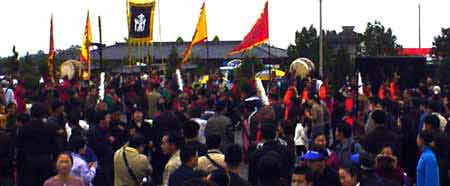The phantom Chairmen
September 22, 2005
How many Maos does it take to change a nation?
YU ZHIJIAN, the Tian'anmen dissident who stayed behind, points out in a recent essay that there is a spectre haunting China - the spectre of Chairman Mao.
While the majority of people are very clear about the precise nature of Mao's 'contributions' to recent Chinese history, there are still those who revere the old leader, and these can be divided into four particular types, each with their own different version of Mao, Yu writes.
The first category is, not surprisingly, the leadership, who use Marxism-Leninism-Maoism to protect their own interests as a ruling elite. Yu explains that although Deng Xiaoping abandoned the bulk of Mao Zedong Thought, he 'inherited Mao's political legacy of the one-party state'. He also chose to identify 'scientific' Mao Zedong Thought as an evolving embodiment of current political realities. The unchanging set of dogmas that had left the country ruined after the Cultural Revolution were, in actual fact, caused by Mao's own deviation from scientific Mao Zedong Thought.
While the leadership centred around Deng used the Democracy Wall movement to do away with the rule of Mao's chosen successor, Hua Guofeng, they were unable to completely repudiate the Mao era because 'their source of power was not sufficiently legitimate and the foundations of their rule was not sufficiently stable', Yu says.
There are also, says Yu, the indoctrinated masses who have been educated to worship the late Chairman, the founder of the New China, the Great Helmsman. There are, too, the 'genuine seekers of Mao Zedong Thought' (many of whom are not Chinese at all but the grisly remnants of the 1960s revolutionary left). They 'proclaim the truth of Marxism-Leninism-Maoism' and still yearn to replace the current 'Hu-Wen system' with the 'Mao line'. They look down on 'traitors' like Deng Xiaoping and Jiang Zemin, and take particular pleasure in the classic Maoist formulation of 'capitalist roaders within the party'.
The fourth category, though, is perhaps the most interesting. Yu Zhijian draws attention to a generation of idealists brought up by the Party to believe in the rhetoric of revolutionary justice, and now forced to square such rhetoric with the 'actually-existing' version of socialism that now operates. Nietzsche once wrote that in every political party there were those who through the credulous zealotry of their faith in party principles drove all the other members to apostacy. As the Slovenian philosopher Slavoj Zizek once suggested in the context of Tito and his 'self-management socialism' movement, the last thing a ruling power wants is its citizens to truly believe what the government is saying.
Yu Zhijian points out that there are those who now use Mao Zedong Thought as a way of protesting against the leadership. 'While the authorities use Mao Zedong to legitimize power, [certain people] use Mao Zedong to legitimize their protests.' They 'oppose the Red Flag by raising it'.
He reminds us of a protest in Guangdong, in which irate villagers evicted from their land by corrupt officials chose to register their discontent by carrying images of Mao and by citing the ideals that Mao is – according to government propaganda - supposed to represent.
It was Yu Zhijian, along with Yu Dongyue and Lu Decheng, who defaced the portrait of Chairman Mao on Tian'anmen Square in 1989. Like Mao, they all hailed from Hunan Province.





